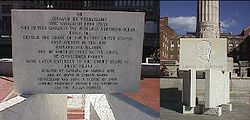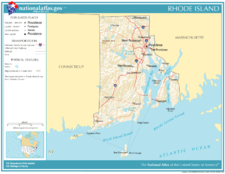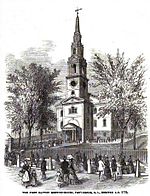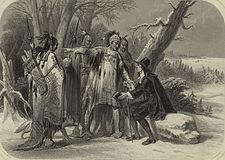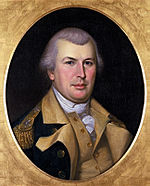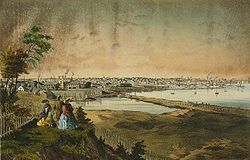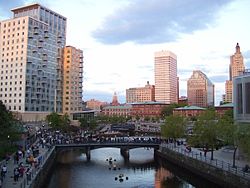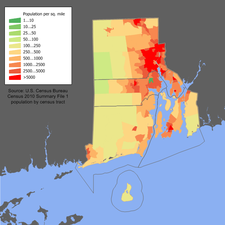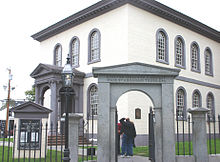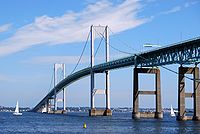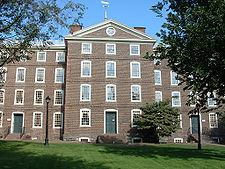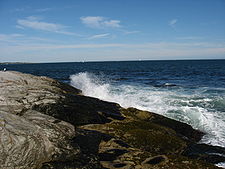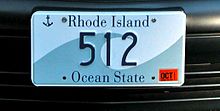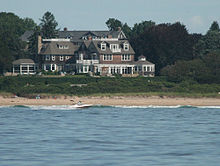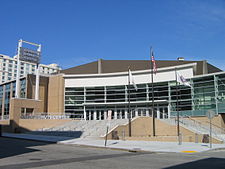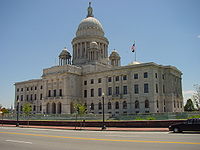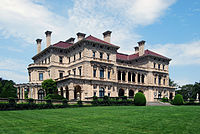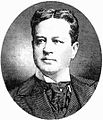- Rhode Island
-
This article is about the U.S. state of Rhode Island. For other uses, see Rhode Island (disambiguation)."RI" and "R.I." redirect here. For other uses, see RI (disambiguation).
State of Rhode Island and Providence Plantations 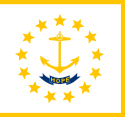

Flag Seal Nickname(s): The Ocean State
Little Rhody[1]Motto(s): Hope Official language(s) De jure: None
De facto: EnglishDemonym Rhode Islander Capital
(and largest city)Providence Area Ranked 50th in the U.S. - Total 1,214[2] sq mi
(3,140 km2)- Width 37 miles (60 km) - Length 48 miles (77 km) - % water 13.9% - Latitude 41° 09' N to 42° 01' N - Longitude 71° 07' W to 71° 53' W Population Ranked 43rd in the U.S. - Total 1,052,567 (2010) - Density 1,012.3/sq mi (390.78/km2)
Ranked 2nd in the U.S.- Median income $54,619 (16th) Elevation - Highest point Jerimoth Hill[3][4]
811 ft (247 m)- Mean 200 ft (60 m) - Lowest point Atlantic Ocean[3]
sea levelAdmission to Union May 29, 1790 (13th) Governor Lincoln Chafee (I) Lieutenant Governor Elizabeth H. Roberts (D) Legislature General Assembly - Upper house Senate - Lower house House of Representatives U.S. Senators Jack Reed (D)
Sheldon Whitehouse (D)U.S. House delegation 1: David Cicilline (D)
2: James Langevin (D) (list)Time zone Eastern: UTC-5/-4 Abbreviations RI US-RI Website ri.gov Footnotes: * Total area is approximately 776,957 acres (3,144 km2) The state of Rhode Island and Providence Plantations,[5] more commonly referred to as Rhode Island (/ˌroʊd ˈaɪlɨnd/ (
 listen) or English pronunciation: /rɵˈdaɪlɨnd/), is a state in the New England region of the United States. It is the smallest U.S. state by area. Rhode Island is bordered by Connecticut to the west and Massachusetts to the north and east, and it shares a water boundary with New York's Long Island to the southwest.
listen) or English pronunciation: /rɵˈdaɪlɨnd/), is a state in the New England region of the United States. It is the smallest U.S. state by area. Rhode Island is bordered by Connecticut to the west and Massachusetts to the north and east, and it shares a water boundary with New York's Long Island to the southwest.Rhode Island was the first of the 13 original colonies to declare independence from British rule, declaring itself independent on May 4, 1776, two months before any other state and the convention. The state was also the last to ratify the United States Constitution.[6][7]
Rhode Island's official nickname is "The Ocean State", a reference to the state's geography, since Rhode Island has several large bays and inlets that amount to about 14% of its total area. Its land area is 1,045 square miles (2706 km2), but its total area is significantly larger.
Contents
Origin of the name
Despite the name, most of Rhode Island is on the mainland United States. The official name of the state, Rhode Island and Providence Plantations, derives from the merger of two colonies. Rhode Island colony was founded near present-day Newport, on what is now commonly called Aquidneck Island, the largest of several islands in Narragansett Bay. Providence Plantations was the name of the colony founded by Roger Williams in the area now known as the City of Providence. [8]
It is unclear how Aquidneck Island came to be known as Rhode Island. In 1524, the explorer Giovanni da Verrazzano noted the presence of an island near the mouth of Narragansett Bay, which he likened to the Greek island of Rhodes. Although it is unclear to which island Verrazzano was referring, the pilgrims who later colonized the area decided to apply the moniker "Rhode Island" to Aquidneck Island. The earliest known use of the name "Rhode Island" was in 1637 by Roger Williams. The name was officially applied to the island in 1644 with these words: "Aquethneck shall be henceforth called the Ile of Rods or Rhod-Island." The name "Isle of Rodes" is found used in a legal document as late as 1646.[9][10]
Another popular origin theory is based on the fact that Adriaen Block, during his expeditions in the 1610s, passed by Aquidneck Island, described in a 1625 account of his travels as "an island of reddish appearance" (in 17th-century Dutch, "een rodlich Eylande").[11] Dutch maps from as early as 1659 call the island "Roode Eylant", or Red Island. Historians have theorized that the island was named by the Dutch (possibly by Adriaen Block himself) for either the red autumn foliage or red clay on portions of the shore.[12][13][13]
Roger Williams was a theologian forced out of the Massachusetts Bay Colony. Seeking religious and political tolerance, he and others founded "Providence Plantations" as a free proprietary colony. "Providence" referred to the divine providence and "plantations" referred to an English term for a colony.
"Rhode Island and Providence Plantations" is the longest official name of any state in the Union. On June 25, 2009, the General Assembly voted to allow the people to decide whether to keep the name or drop "Providence Plantations" due to the misperception that the name relates to slavery.[14] The referendum election was held on this subject during the November 2, 2010 elections, and the people overwhelmingly voted (78% to 22%) to keep the original name.[15]
Geography
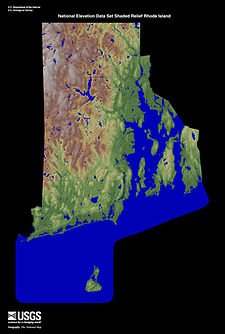 Terrain Map of Rhode Island
Terrain Map of Rhode Island Further information: List of counties in Rhode Island
Further information: List of counties in Rhode IslandRhode Island covers an area of approximately 1,214 square miles (3,140 km2) and is bordered on the north and east by Massachusetts, on the west by Connecticut, and on the south by Rhode Island Sound and the Atlantic Ocean.[2] It shares a narrow maritime border with New York State between Block Island and Long Island. The mean elevation of the state is 200 feet (60 m).
Nicknamed the Ocean State, Rhode Island has a number of oceanfront beaches. It is mostly flat with no real mountains, and the state's highest natural point is Jerimoth Hill, 812 feet (247 m) above sea level.[16]
Located within the New England province of the Appalachian Region, Rhode Island has two distinct natural regions. Eastern Rhode Island contains the lowlands of the Narragansett Bay, while Western Rhode Island forms part of the New England Upland. Rhode Island's forests are part of the Northeastern coastal forests ecoregion.[17]
Narragansett Bay is a major feature of the state's topography. Block Island lies approximately 12 miles (19 km) off the southern coast of the mainland. Within the Bay, there are over 30 islands. The largest is Aquidneck Island, shared by the municipalities of Newport, Middletown, and Portsmouth. The second-largest island is Conanicut; the third-largest is Prudence.
Geology
A rare type of rock called Cumberlandite, found only in Rhode Island (specifically in the town of Cumberland), is the state rock. There were initially two known deposits of the mineral, but since it is an ore of iron, one of the deposits was extensively mined for its ferrous content.
Climate
Rhode Island is an example of a humid continental climate with warm, rainy summers and chilly winters. The highest temperature recorded in Rhode Island was 104 °F (40 °C), recorded on August 2, 1975, in Providence.[18] The lowest recorded temperature in Rhode Island was −25 °F (−32 °C), on February 5, 1996, in Greene.[19] Monthly average temperatures range from a high of 83 °F (28 °C) to a low of 20 °F (−7 °C).[20]
History
Main article: History of Rhode IslandColonial era: 1636–1770
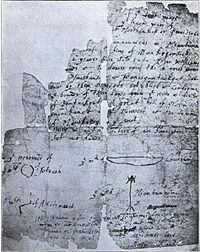 The original 1636 deed to Providence, signed by Chief Canonicus.
The original 1636 deed to Providence, signed by Chief Canonicus. Main article: Colony of Rhode Island and Providence Plantations
Main article: Colony of Rhode Island and Providence PlantationsIn 1636, Roger Williams, after being banished from the Massachusetts Bay Colony for his religious views, settled at the tip of Narragansett Bay, on land granted to him by the Narragansett and Pequot tribes. He called the site Providence and declared it a place of religious freedom. Detractors of the idea of liberty of conscience sometimes referred to it as "Rogue's Island".[21] In 1638, after conferring with Williams, Anne Hutchinson, William Coddington, John Clarke, Philip Sherman, and other religious dissidents settled on Aquidneck Island (then known as Rhode Island), which was purchased from the local natives, who called it Pocasset. The settlement of Portsmouth was governed by the Portsmouth Compact. The southern part of the island became the separate settlement of Newport after disagreements among the founders.
Samuel Gorton purchased the Native American lands at Shawomet in 1642, precipitating a military dispute with the Massachusetts Bay Colony. In 1644, Providence, Portsmouth, and Newport united for their common independence as the Colony of Rhode Island and Providence Plantations, governed by an elected council and "president". Gorton received a separate charter for his settlement in 1648, which he named Warwick after his patron.[22]
Although Rhode Island remained at peace with the Native Americans, the relationship between the other New England colonies and the Native Americans was more strained, and sometimes led to bloodshed, despite attempts by the Rhode Island leadership to broker peace. During King Philip's War (1675–1676), both sides regularly violated Rhode Island's neutrality. The war's largest battle occurred in Rhode Island, when a force of Massachusetts, Connecticut and Plymouth militia under General Josiah Winslow invaded and destroyed the fortified Narragansett Indian village in the Great Swamp in southern Rhode Island, on December 19, 1675.[23] The Narragansett also invaded, and burnt down several of the cities of Rhode Island, including Providence, although they allowed the population to leave first. Also in one of the final actions of the war, troops from Connecticut hunted down and killed "King Philip", as they called the Wampanoag war-leader Metacomet, on Rhode Island's territory.
The colony was amalgamated into the Dominion of New England in 1686, as James II of England attempted to enforce royal authority over the autonomous colonies in British North America. After the Glorious Revolution of 1688, the colony regained its independence under the Royal Charter. The bedrock of the economy continued to be agriculture, especially dairy farming, and fishing. Lumber and shipbuilding also became major industries. Slaves were introduced at this time, although there is no record of any law relegalising slave-holding. Ironically, the colony later prospered under the slave trade, by distilling rum to sell in Africa as part of a profitable triangular trade in slaves and sugar with the Caribbean.[24]
Rhode Island was the first of the thirteen colonies to renounce its allegiance to the British Crown, on May 4, 1776. It was also the last colony of the thirteen colonies to ratify the United States Constitution on May 29, 1790, once assurances were made that a Bill of Rights would become part of the Constitution.[25] As the home of Brown University, Rhode Island is one of only eight states hosting a colonial college chartered on its territory prior to the American Revolution.
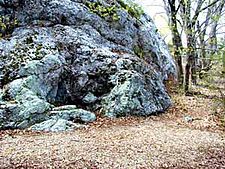 "King Philip's Seat", a Native American meeting place on Mount Hope
"King Philip's Seat", a Native American meeting place on Mount Hope
Revolution to industrialization: 1770–1860
Rhode Island's tradition of independence and dissent gave it a prominent role in the American Revolution. In 1772, the first bloodshed of the American Revolution took place in Rhode Island when a band of Providence residents attacked a grounded British ship for enforcing unpopular British trade regulations. This incident would come to be known as the Gaspee Affair. Rhode Island was the first of the original thirteen colonies to declare its independence from Great Britain (May 4, 1776),[26] and the last to ratify the Constitution, doing the latter only after being threatened with having its exports taxed as a foreign nation.
During the Revolution, the British occupied Newport. A combined Franco-American force fought to drive them off of Aquidneck Island. Portsmouth was the site of the first African American military unit, the 1st Rhode Island Regiment, to fight for the U.S. in the Battle of Rhode Island August 29, 1778. The arrival of a far superior French fleet forced the British to scuttle their own ships, rather than surrender them to the French.
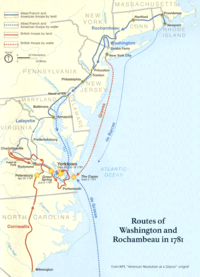 National Park Service map of the Washington-Rochambeau Revolutionary Route, which commenced in Rhode Island.
National Park Service map of the Washington-Rochambeau Revolutionary Route, which commenced in Rhode Island.
The celebrated march of 1781 to Yorktown, Virginia that ended with the defeat of the British at the Siege of Yorktown and the Battle of the Chesapeake began in Newport, Rhode Island under the joint command of General George Washington who led American troops and the Comte de Rochambeau who led French soldiers sent by King Louis XVI. In 2009, it was officially recognized by the National Park Service.
These allied forces spent one year in Providence, Rhode Island, including at Brown University's University Hall, preparing for an opportune moment to begin their decisive march. Several patriots residing in Rhode Island were involved in the American Revolution, including Royal Governor Samuel Ward, Royal Governor and first Brown University Chancellor Stephen Hopkins, the Reverend James Manning, General James Mitchell Varnum, John Brown, Dr. Solomon Drowne, Yale College president Ezra Stiles and first United States Senator from Rhode Island Theodore Foster.
The Industrial Revolution began in America in 1787 when Thomas Somers reproduced textile machine plans he imported from England. He helped to produce the Beverly Cotton Manufactory, which Moses Brown of Providence took an interest in. Teaming up with Samuel Slater, Moses Brown helped to create the second cotton mill in America, a water-powered textile mill. As the Industrial Revolution moved large numbers of workers into the cities, a permanently landless, and therefore voteless, class developed. By 1829, 60% of the state's free white males were ineligible to vote.
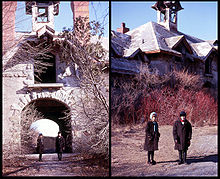 Abandoned mill outside Newport (1968)
Abandoned mill outside Newport (1968)
Several attempts had been made to address this problem, but none were successful. In 1842, Thomas Dorr drafted a liberal constitution which was passed by popular referendum. However, the conservative sitting governor, Samuel Ward King, opposed the people's wishes, leading to the Dorr Rebellion. Although this was not a success, a modified version of the constitution was passed in November, which allowed any white male to vote if he owned land or could pay a $1 poll tax.
In addition to industrialization, Rhode Island was heavily involved in the slave trade during the post-revolution era. Slavery was extant in the state as early as 1652, and by 1774, the slave population of Rhode Island was 6.3%, nearly twice as high as any other New England colony. In the late 18th century, several Rhode Island merchant families began actively engaging in the triangle slave trade. Notable among these was Rhode Island Senator James De Wolf and his family, as well as brothers John and Nicholas of the Brown family, for whom Brown University is named, although some Browns, particularly Moses, became prominent abolitionists. In the years after the Revolution, Rhode Island merchants controlled between 60% and 90% of the American trade in African slaves.[27][28]
Civil War to Progressive Era: 1860–1929
During the Civil War, Rhode Island was the first Union state to send troops in response to President Lincoln's request for help from the states. Rhode Island furnished 25,236 fighting men, of whom 1,685 died. On the home front, Rhode Island, along with the other northern states, used its industrial capacity to supply the Union Army with the materials it needed to win the war. The United States Naval Academy moved here temporarily during the war.
In 1866, Rhode Island abolished racial segregation in the public schools throughout the state.[29]
Post-war immigration increased the population. From the 1860s to the 1880s, most immigrants were from England, Ireland, Germany, Sweden, and Quebec. Toward the end of the century, however, most immigrants were from Eastern Europe and the Mediterranean.[30] At the turn of the century, Rhode Island had a booming economy, which fed the demand for immigration. In the years leading up to World War I, Rhode Island's constitution remained reactionary, in contrast to the more progressive reforms that were occurring in the rest of the country. The state never ratified the 18th Amendment establishing national prohibition of alcohol.[31]
During World War I, Rhode Island furnished 28,817 troops, of whom 612 died. After the war, the state was hit hard by the Spanish Influenza.[32] In the 1920s and 1930s, rural Rhode Island saw a surge in Ku Klux Klan membership, largely in reaction to the large waves of immigrants moving to the state. The Klan is believed to be responsible for burning the Watchman Industrial School in Scituate, which was a school for African American children.[33]
Growth in the modern era: 1929–present
In the 20th century, the state continued to grow, though the decline in industry devastated many urban areas. These areas were affected further, as with the rest of the country's urban areas, by construction of Interstate highways through city cores and the suburbanization caused by it and by the GI Bill.
Since the Great Depression, the Rhode Island Democratic Party has dominated local politics. Rhode Island has comprehensive health insurance for low-income children, and a large social safety net. Many urban areas still have a high rate of children in poverty. Due to an influx of residents from Boston, increasing housing costs have resulted in more homeless in Rhode Island.[34]
The 350th Anniversary of Rhode Island was celebrated with a free concert held on the tarmac of the Quonset State Airport. Performers included Chuck Berry, Tommy James and headliner Bob Hope.
The Republican Party, virtually non-existent in the state legislature, has successfully nominated state-wide "good government" reform candidates who criticize the state's high taxes and what they claim are excesses of the Democratic Party. Former Governor Donald Carcieri of East Greenwich, and former Mayor Vincent A. "Buddy" Cianci of Providence (who later became an independent political leader, and was convicted on RICO charges) ran as Republican reform candidates.
In 2003, a nightclub fire in West Warwick claimed one hundred lives and caught national attention. The fire resulted in criminal sentences.[35]
In March 2010, areas of the state received record flooding due to rising rivers from heavy rain. The first period of rainy weather in mid-March caused localized flooding, but just two weeks later, more rain caused more widespread flooding in many towns, especially south of Providence. Rain totals on March 29–30, 2010 exceeded 14 inches in many locales, resulting in the inundation of area rivers—especially the Pawtuxet River which runs through central Rhode Island.
The overflow of the Pawtuxet River, nearly 11 feet (3.4 m) above flood stage, submerged a sewage plant and closed a five mile (8 km) stretch of Interstate 95. In addition, it flooded two shopping malls, numerous businesses, and many homes in Warwick, West Warwick, Cranston, and Westerly;Amtrak service between New York and Boston was also suspended during this period. Following the flood, Rhode Island was in a state of emergency for two days and President Obama came to neighboring Massachusetts to assess the damage; FEMA was also called in to help flood victims.
Law and government
Presidential elections results Year Republican Democratic 2008 35.21% 165,391 63.13% 296,571 2004 38.67% 169,046 59.42% 259,760 2000 31.91% 130,555 60.99% 249,508 1996 26.82% 104,683 59.71% 233,050 1992 29.02% 131,601 47.04% 213,299 1988 43.93% 177,761 55.64% 225,123 1984 51.66% 212,080 48.02% 197,106 1980 37.20% 154,793 47.70% 198,342 1976 44.10% 181,249 55.40% 227,636 1972 53.00% 220,383 46.80% 194,645 1968 31.80% 122,359 64.00% 246,518 1964 19.10% 74,615 80.90% 315,463 1960 36.40% 147,502 63.60% 258,032 1956 58.30% 225,819 41.70% 161,790 1956 50.90% 210,935 49.10% 203,293 The capital of Rhode Island is Providence. The state's current governor is Lincoln Chafee (I), and the lieutenant governor is Elizabeth H. Roberts (D). Its United States Senators are Jack Reed (D) and Sheldon Whitehouse (D). Rhode Island's two United States Congressmen are David Cicilline (D-1) and Jim Langevin (D-2). See congressional districts map.
Rhode Island is one of a few states that does not have an official Governor's residence. See List of Rhode Island Governors.
The state legislature is the Rhode Island General Assembly, consisting of the 75-member House of Representatives and the 38-member Senate. Both houses of the bicameral body are currently dominated by the Democratic Party.
Because Rhode Island's population barely crosses the threshold for additional votes in both the federal House and electoral college, it is well represented relative to its population, with the eighth-highest number of electoral votes and second-highest number of House Representatives per resident. Based on its area, Rhode Island even has the highest density of electoral votes.[36]
Federally, Rhode Island is one of the most reliably Democratic states during presidential elections, regularly giving the Democratic nominees one of their best showings. In the 1980 U.S. Presidential Election, Rhode Island was one of only 6 states to vote against Ronald Reagan. Reagan did carry Rhode Island in his 49-state victory in 1984, but the state was the second weakest of the states Reagan won. Rhode Island was the Democrats' leading state in 1988 and 2000, and second-best in 1966, 1996 and 2004. Rhode Island's most one sided Presidential election result was in 1964; over 80% of Rhode Islanders voted for Lyndon B. Johnson. The last fifteen Presidential elections in Rhode Island have resulted in the Democratic party winning the State's electoral college votes eleven times. The state was devoted to Republicans until 1908, but has only strayed from the Democrats 7 times in the 24 elections that have followed. In 2004, Rhode Island gave John Kerry more than a 20-percentage-point margin of victory (the third-highest of any state), with 59.4% of its vote. All but three of Rhode Island's 39 cities and towns voted for the Democratic candidate. The only exceptions were East Greenwich, West Greenwich and Scituate.[37] In 2008, Rhode Island gave Barack Obama a 29-percentage-point margin of victory (the third-highest of any state), with 64% of its vote. All of Rhode Island's 39 cities and towns voted for the Democratic candidate, except for Scituate.[38] Also, the 2008 Presidential election brought out 83% of the active voters in the State.
Further information: Political party strength in Rhode IslandVoter registration and party enrollment as of March 15, 2011[39][40] Party Active voters Inactive voters Total voters Percentage Democratic 124,088 10,729 134,817 19.54% Republican 72,033 7,392 79,425 11.51% Moderate 5,532 101 5,633 0.82% Unaffiliated 430,123 39,953 470,076 68.13% Total 631,776 58,175 689,951 100% Rhode Island has abolished capital punishment, making it one of 15 states that have done so. Rhode Island abolished the death penalty very early, just after Michigan, the first state to abolish it, and carried out its last execution in the 1840s. Rhode Island was the second to last state to make prostitution illegal. Until November 2009 Rhode Island law made prostitution legal provided it took place indoors.[41] In a 2009 study Rhode Island was listed as the 9th safest state in the country.[42]
In 2011 Rhode Island became the third state in the United States to pass legislation to allow the use of medical marijuana. Additionally the Rhode Island General Assembly passed civil unions and it was signed into law by Governor Lincoln Chafee on July 2, 2011. Rhode Island became the eighth state to fully recognize either same-sex marriage or civil unions.[43]
Rhode Island has some of the highest taxes in the country, particularly its property taxes, ranking seventh in local and state taxes, and sixth in real estate taxes.[44]
Demographics
Historical populations Census Pop. %± 1790 68,825 — 1800 69,122 0.4% 1810 76,931 11.3% 1820 83,059 8.0% 1830 97,199 17.0% 1840 108,830 12.0% 1850 147,545 35.6% 1860 174,620 18.4% 1870 217,353 24.5% 1880 276,531 27.2% 1890 345,506 24.9% 1900 428,556 24.0% 1910 542,610 26.6% 1920 604,397 11.4% 1930 687,497 13.7% 1940 713,346 3.8% 1950 791,896 11.0% 1960 859,488 8.5% 1970 946,725 10.1% 1980 947,154 0% 1990 1,003,464 5.9% 2000 1,048,319 4.5% 2010 1,052,567 0.4% Demographics of Rhode Island (csv) By race White Black AIAN* Asian NHPI* 2000 (total population) 90.96% 6.45% 1.07% 2.74% 0.19% 2000 (Hispanic only) 7.14% 1.42% 0.18% 0.08% 0.07% 2005 (total population) 90.16% 7.07% 1.09% 3.07% 0.21% 2005 (Hispanic only) 9.12% 1.49% 0.22% 0.08% 0.08% Growth 2000–05 (total population) 1.76% 12.52% 4.91% 15.09% 9.93% Growth 2000–05 (non-Hispanic only) -0.75% 13.80% 1.03% 15.44% 8.90% Growth 2000–05 (Hispanic only) 31.21% 7.98% 24.03% 3.78% 11.64% * AIAN is American Indian or Alaskan Native; NHPI is Native Hawaiian or Pacific Islander The center of population of Rhode Island is located in Providence County, in the city of Cranston.[45] A corridor of population can be seen from the Providence area, stretching northwest following the Blackstone River to Woonsocket, where nineteenth-century mills drove industry and development. According to the U.S. Census Bureau, as of 2005, Rhode Island had an estimated population of 1,076,189, which is a decrease of 3,727, or 0.3%, from the prior year and an increase of 27,870, or 2.7%, since the year 2000. This includes a natural increase since the last census of 15,220 people (that is 66,973 births minus 51,753 deaths) and an increase due to net migration of 14,001 people into the state. Immigration from outside the United States resulted in a net increase of 18,965 people, and migration within the country produced a net decrease of 4,964 people.
The ten largest ancestry groups in Rhode Island are:
 19.0% Italian
19.0% Italian
 18.3% Irish
18.3% Irish
 12.1% English
12.1% English
 8.2% Portuguese
8.2% Portuguese
 8.0% French
8.0% French
 6.4% French Canadian
6.4% French Canadian
 4.4% Guatemalan
4.4% Guatemalan
 3.6% Puerto Rican
3.6% Puerto Rican
 3.5% Dominican
3.5% Dominican
 2.2% Chinese
2.2% ChineseHispanics in the state make up 12.7% of the population, predominantly Guatemalan, Puerto Rican, and Dominican populations.[46]
According to the 2000 U.S. Census, 8.07% of the population aged 5 and older speaks Spanish at home, while 3.80% speaks Portuguese, 1.96% French, and 1.39% Italian.[47]
6.1% of Rhode Island's population were reported as under 5, 23.6% under 18, and 14.5% were 65 or older. Females made up approximately 52% of the population.
Rhode Island has a higher percentage of Americans of Portuguese ancestry, including Portuguese Americans and Cape Verdean Americans than any other state in the nation. Additionally, the state also has the highest percentage of Liberian immigrants, with more than 15,000 residing in the State.[48] Italian Americans make up a plurality in central and southern Providence County and French Canadians form a large part of northern Providence County. Irish Americans have a strong presence in Newport and Kent counties. Yankees of English ancestry still have a presence in the State as well, especially in Washington County, and are often referred to as "Swamp Yankees." African immigrants, including Cape Verdean Americans, Liberian Americans, Nigerian Americans and Ghanaian Americans, form significant and growing communities in Rhode Island. Additionally, although Rhode Island has the smallest total area of all fifty states, it has the second highest population density of any state in the Union, second only to New Jersey.
Religion
The religious affiliations of the people of Rhode Island are:[49]
- Christian – 87.5%
-
- Roman Catholic – 63.6%
- Protestant – 21.6%
-
- Episcopal – 8.1%
- Baptist – 6.3%
- Evangelical – 4%
- other – 3.2%
- Other Christian – 2.3%
The largest single Protestant denominations are the Episcopals with 26,756 and the Baptists with 20,997 adherents.[50]
The Jewish community of Rhode Island is centered in the Providence area, and emerged during a wave of Jewish immigration (predominately) from the Shtetl between 1880 and 1920. The presence of the Touro Synagogue in Newport, the oldest existing synagogue in the United States, emphasizes that these second-wave immigrants did not create Rhode Island's first Jewish community; A comparatively smaller wave of Portuguese Jews immigrated to Newport during the colonial era.
Rhode Island has the highest percentage of Roman Catholics[51] in the nation mainly due to large Irish, Italian, and French Canadian immigration in the past; recently, significant Portuguese and various Hispanic communities have also been established in the state. Though it has the highest overall Catholic percentage of any state, none of Rhode Island's individual counties ranks among the 10 most Catholic in the United States, as Catholics are very evenly spread throughout the state. Additionally, Rhode Island and Utah are the only two states in which a majority of the population are members of a single religious body.
Cities and towns
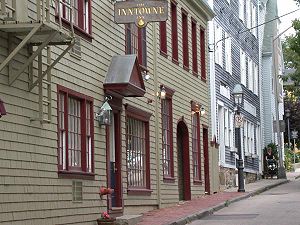 A historic side street in Newport
A historic side street in Newport Main article: Cities and towns in Rhode IslandSee also: Rhode Island locations by per capita income and Category:Villages in Rhode Island
Main article: Cities and towns in Rhode IslandSee also: Rhode Island locations by per capita income and Category:Villages in Rhode IslandRhode Island, along with Connecticut and to a partial extent the rest of New England, does not have county government. The entire state is divided into municipalities, which handle all local government
There are 39 cities and towns in Rhode Island. Major population centers today result from historical factors—with the advent of the water-powered mill development took place predominantly along the Blackstone, Seekonk, and Providence Rivers. Providence is the base of a large metropolitan area.
Ranked by population, the state's 15 largest municipalities are:
- Providence (178,042)[52]
- Warwick (82,672)[53]
- Cranston (80,387)[54]
- Pawtucket (71,148)[55]
- East Providence (47,034)[56]
- Woonsocket (40,186)[57]
- Coventry (36,014)[58]
- Cumberland (32,506)[58]
- North Providence (32,078)[58]
- South Kingstown (30,639)[58]
- West Warwick (29,191)[58]
- Johnston (28,768)[58]
- North Kingstown (26,486)[58]
- Newport (24,672)[59]
- Bristol (22,954)[58]
In common with many other New England states, some Rhode Island cities and towns are further partitioned into villages that reflect historic townships which were later combined for administrative purposes. Notable villages include Kingston, in the town of South Kingstown, which houses the University of Rhode Island, and Wickford, in North Kingstown, the site of an annual international art festival.
Economy
Textron's headquarters, in the company of One Financial Plaza and the Rhode Island Hospital Trust building.
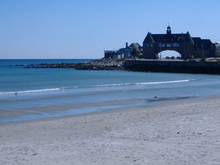 Narragansett Towers and Narragansett Town Beach, one of Rhode Island's tourist destinations.
Narragansett Towers and Narragansett Town Beach, one of Rhode Island's tourist destinations.
The Rhode Island economy had a colonial base in fishing. The Blackstone River Valley was a major contributor to the American Industrial Revolution". It was in Pawtucket that Samuel Slater set up Slater Mill in 1793,[60] using the waterpower of the Blackstone River to power his cotton mill. For a while, Rhode Island was one of the leaders in textiles. However, with the Great Depression, most textile factories relocated to southern US states. The textile industry still constitutes a part of the Rhode Island economy, but does not have the same power that it once had.
Other important industries in Rhode Island's past included toolmaking, costume jewelry and silverware. An interesting by-product of Rhode Island's industrial history is the number of abandoned factories—many of them now being used for condominiums, museums, offices, and low-income and elderly housing. Today, much of the economy of Rhode Island is based in services, particularly healthcare and education, and still to some extent, manufacturing.[61][62]
The headquarters of Citizens Financial Group, the 14th largest bank in the United States, is located in Providence.[63] The Fortune 500 companies CVS Caremark and Textron are based in Woonsocket and Providence, respectively. FM Global, GTECH Corporation, Hasbro, American Power Conversion, Nortek, and Amica Mutual Insurance are all Fortune 1000 companies that are based in Rhode Island.[64]
Rhode Island's 2000 total gross state product was $33 billion, placing it 45th in the nation. Its 2000 per capita personal income was $29,685, 16th in the nation. Rhode Island has the lowest level of energy consumption per capita of any state.[65][66][67] Additionally, Rhode Island is a rated as the 5th most energy efficient state in the country.[68][69] As of Dec. 2010, the state's unemployment rate is 11.5%.[70]
Health services are Rhode Island's largest industry. Second is tourism, supporting 39,000 jobs, with tourism-related sales at $3.26 billion in the year 2000. The third-largest industry is manufacturing.[71] Its industrial outputs are costume jewelry, fabricated metal products, electrical equipment, machinery, shipbuilding and boatbuilding. Rhode Island's agricultural outputs are nursery stock, vegetables, dairy products and eggs.
Rhode Island's taxes were appreciably higher than neighboring states,[44] because Rhode Island's income tax was based on 25% of the payer's federal income tax payment.[72] Governor Carcieri has claimed that the higher tax rate had an inhibitory effect on business growth in the state and called for reductions to increase the competitiveness of the state's business environment. In 2010, the Rhode Island General Assembly passed a new state income tax structure that was then signed into law on June 9, 2010, by Governor Carcieri.[73] The income tax overhaul has now made Rhode Island competitive with other New England states by lowering its maximum tax rate to 5.99% and has reduced the number of tax brackets to three.[74] The state's first income tax was first enacted in 1971.[75]
Largest employers
As of March 2011, the largest employers in Rhode Island (excluding employees of municipalities) are the following:[76]
Rank Employer Employees Notes 1 State of Rhode Island 14,904 Full-time equivalents 2 Lifespan Hospital Group 11,869 Rhode Island Hospital (7,024 employees), The Miriam Hospital (2,410), Newport Hospital (919), Emma Pendleton Bradley Hospital (800), Lifespan Corporate Services (580), Newport Alliance Newport (68), Lifespan MSO (53), and Home Medical (15) 3 U.S. federal government 11,581 Excludes 3,000 active duty military personnel and 7,000 reservists, but includes 250 employees of the Naval War College. 4 Roman Catholic Diocese of Providence 6,200 5 Care New England 5953 Plans to merge with Lifespan within the next year. Employees at: Women & Infants Hospital of Rhode Island (3,134), Kent County Memorial Hospital (1,850), Butler Hospital (800), VNA of Care New England (140), and Care New England (29) 6 CVS Caremark 5800 The corporate headquarters are at Woonsocket (5,630 employees). The corporation also has 170 employees at Pharmacare 7 Citizens Financial Group
(subsidiary of Royal Bank of Scotland Group)4,991 8 Brown University 4,800 Excludes student employees. 9 Stop & Shop Supermarket
(subsidiary of Ahold)3,632 10 Bank of America 3,500 11 Fidelity Investments 2,934 2,434 employees in Smithfield and 500 in Providence 12 Rhode Island ARC 2,851 Employees at James L. Maher Center (700), The Homestead Group (650), Cranston Arc (374), The ARC of Blackstone Valley (350), Kent County ARC (500), The Fogarty Center (225), and Westerly Chariho, ARC (52) 13 MetLife Insurance Co. 2,604 14 General Dynamics Corp. 2,243 2,200 employees at General Dynamics Electric Boat in North Kingstown, and 43 employees at General Dynamics Electric Boat - Newport in Middletown adjacent to the Naval Undersea Warfare Center[77] 15 University of Rhode Island 2,155 16 Wal-Mart 2,078 17 The Jan Companies 2050 Employees at Jan-Co Burger King (1,500) (Burger King franchiser); Newport Creamery, LLC (400), Quidnessett Country Club (100), and The Country Inn (50) 18 Shaw's Supermarkets
(subsidiary of SuperValu Inc.)1,900 19 St. Joseph Health Services and Hospitals of Rhode Island/CharterCARE Health Partners 1,865 Employees at Our Lady of Fatima Hospital (1,343) and St. Joseph Hospital for Specialty Care (522) 20 The Home Depot, Inc. 1,780 Transportation
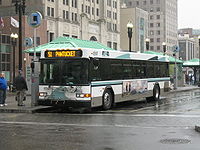 A RIPTA bus at Kennedy Plaza.
A RIPTA bus at Kennedy Plaza.
The Rhode Island Public Transit Authority (RIPTA), which has its hub in downtown Providence manages local bus transit for the state, serving 38 out of 39 Rhode Island communities. RIPTA has 58 bus lines, 2 tourist trolley lines known as LINK, and a seasonal ferry to Newport.[78] The MBTA commuter rail Providence/Stoughton Line services downtown Providence as well as T. F. Green Airport and connects to Boston. Amtrak's Acela Express has a station in Providence and links the city to other cities on the Northeast Corridor. Kingston station is served by the Northeast Regional, and is the only place where you can stand 2 feet away from the Acela Express, which runs past the station at 150 miles per hour. Free transportation between Providence and Boston is available for military personnel via train.[citation needed] Ferry services link Block Island, Prudence Island, and Hog Island to the Rhode Island mainland.
The major airports are T. F. Green Airport in Warwick and Logan International Airport in Boston. A commuter rail brings travelers from T.F. Green Airport to Providence and Boston.
Interstate 95 runs diagonally across the state connecting major population centers, while the auxiliary interstate 295 provides a bypass around Providence. Narragansett Bay has a number of bridge crossings connecting Aquidneck Island and Conanicut Island to the mainland, most notably the Claiborne Pell Newport Bridge and the Jamestown-Verrazano Bridge. I-95 is one of the nation's deadliest highways, especially during the summer months. "Between 2004 and 2008, there were 36 fatal accidents on the highway, at a rate of nearly one accident for every mile."[79]
In March 2011, Rhode Island ranked amongst the top six "Best" states in the American State Litter Scorecard, for overall effectiveness and quality of its public space cleanliness – primarily roadway and adjacent litter – from state and related debris removal efforts.[80]
In June 2011, the state completed work on a marked on-road bicycle path through Pawtucket and Providence, connecting the East Bay Bike Path with the Blackstone River Bikeway, completing a 33.5 miles (53.9 km) bicycle route through the eastern part of the state.[81]
Media
Main article: Media in Rhode IslandEducation
 Bello Center at Bryant University
Bello Center at Bryant University
Primary and secondary schools
Further information: Rhode Island schoolsColleges and universities
Main article: List of colleges and universities in Rhode IslandRhode Island has several colleges and universities:
Culture
Some Rhode Islanders speak with a non-rhotic accent that many compare to a "Brooklyn" or a cross between a New York and Boston accent ("water" becomes "wata"). Many Rhode Islanders distinguish the aw sound [ɔː], as one might hear in New Jersey; e.g., the word coffee is pronounced [ˈkɔːfiː] kaw-fee.[82] This type of accent was brought to the region by early settlers from eastern England in the Puritan migration to New England in the mid-seventeenth century.[83]
Rhode Islanders refer to drinking fountains as "bubblers," (pronounced bub-lhas.)
Nicknamed "The Ocean State", the nautical nature of Rhode Island's geography pervades its culture. Newport Harbor, in particular, holds many pleasure boats. In the lobby of the state's main airport, T. F. Green, is a large life size sailboat,[84] and the state's license plates depict an ocean wave or a sailboat.[85]
Additionally, the large number of beaches in Washington County lures many Rhode Islanders south for summer vacation.[86]
The state was notorious for organized crime activity from the 1950s into the 1990s when the Patriarca crime family held sway over most of New England from its Providence headquarters.
Rhode Islanders developed a unique style of architecture in the 17th century, called the stone-ender.[87]
Rhode Island is the only state to still celebrate Victory over Japan Day. It is known locally as "VJ Day", or simply "Victory Day".[88]
Food and beverages
Several foods and dishes are unique to Rhode Island and some are hard to find outside of the state. Hot wieners, which are sometimes called gaggers, weenies, or New York System wieners, are smaller than a standard hot dog, served covered in a meat sauce, chopped onions, mustard, and celery salt. Famous to Rhode Island is Snail Salad, which is served at numerous restaurants throughout the state. The dish is normally prepared "family style" with over five pounds of snails mixed in with other ingredients commonly found in seafood dishes.[89] Grinders are submarine sandwiches, with a popular version being the Italian grinder, which is made with cold cuts (usually ham, prosciutto, capicola, salami, and Provolone cheese). Linguiça (a spicy Portuguese sausage) and peppers, eaten with hearty bread, is also popular among the state's large Portuguese community.
Pizza strips are prepared in Italian bakeries and sold in most supermarkets and convenience stores, they are rectangular strips of pizza without the cheese and are served cold. Party pizza is a box of these pizza strips. Spinach pies are similar to a calzone but filled with seasoned spinach instead of meat, sauce and cheese. Variations can include black olives or pepperoni with the spinach.
As in colonial times, johnny cakes are made with corn meal and water, then pan-fried much like pancakes. During fairs and carnivals, Rhode Islanders enjoy dough boys, which are plate-sized disks of deep fried dough sprinkled with powdered sugar (or pizza sauce). Zeppole are Italian doughnut-like pastries traditionally eaten on Saint Joseph's Day, often made with exposed centers of vanilla pudding, cream filling, or ricotta cream, and sometimes topped with a cherry.
As in many coastal states, seafood is readily available. Shellfish is extremely popular, with clams being used in multiple ways. The quahog, from the Narragansett Indian word "poquauhock"; see A Key into the Language of America by Roger Williams 1643) is a large clam usually used in a chowder. It is also ground and mixed with stuffing (and sometimes spicy minced sausage) and then baked in its shell to form a stuffie. Steamed clams are also a very popular dish. Calamari (squid) is sliced into rings and fried and is served as an appetizer in most Italian restaurants, typically Sicilian-style, i.e. tossed with sliced banana peppers and with marinara sauce on the side.
Rhode Island, like the rest of New England, has a tradition of clam chowder. While both the white New England variety and the red Manhattan variety are popular, there is also a unique clear chowder, known as Rhode Island Clam Chowder available in many restaurants. According to Good Eats, the addition of tomatoes in place of milk was initially the work of Portuguese immigrants in Rhode Island, as tomato-based stews were already a traditional part of Portuguese cuisine, and milk was costlier than tomatoes. Scornful New Englanders called this modified version "Manhattan-style" clam chowder because, in their view, calling someone a New Yorker was an insult[citation needed].
Perhaps the most unusual culinary tradition in Rhode Island is the clam cake. The clam cake (also known as a clam fritter outside of Rhode Island) is a deep fried ball of buttery dough with chopped bits of clam inside. They are sold by the half-dozen or dozen in most seafood restaurants around the state. The quintessential summer meal in Rhode Island is chowder and clam cakes.
Clams Casino originated in Rhode Island after being invented by Julius Keller, the maitre d' in the original Casino next to the seaside Towers in Narragansett.[90] Clams Casino resemble the beloved stuffed quahog but are generally made with the smaller littleneck or cherrystone clam and are unique in their use of bacon as a topping.
According to a Providence Journal article, the state features both the highest number and highest density of coffee/doughnut shops per capita in the country, with 342 coffee/doughnut shops in the state. At one point, Dunkin' Donuts alone had over 225 locations.[91]
The official state drink of Rhode Island is coffee milk,[92] a beverage created by mixing milk with coffee syrup. This unique syrup was invented in the state and is sold in almost all Rhode Island supermarkets, as well as border states. Although coffee milk contains some caffeine, it is sold in school cafeterias throughout the state. Strawberry milk is also as popular as chocolate milk.
Famous Rhode Islanders
Rhode Island State symbols Animate insignia Bird(s) Rhode Island Red Chicken Fish Striper Bass Flower(s) Violet Tree Red maple Inanimate insignia Beverage Coffee milk Food Rhode Island Greening Apple Mineral Bowenite Rock Cumberlandite Shell Northern Quahog Slogan(s) Unwind, "Hope" Soil Narragansett Song(s) Rhode Island,
Rhode Island, It's for MeTartan Rhode Island Tartan[dead link] Route marker(s) 
State Quarter 
Released in 2001 Lists of United States state insignia Main article: Famous people from Rhode IslandLow numbered license plates
Most people outside of the state do not understand the fascination of wanting and or having a low-numbered license plate. Generally, any plates with four digits or lower are considered a status symbol. Since 1904, when the first black and white porcelain license plates were issued by the state, politicians have handed out low numbered plates as a way to reward supporters or associates. The mindset is that owners are either important enough to have a low-number plate from a politician, or they come from an important family that got the plate years ago. State officials have seemingly legitimized this furor by making Rhode Island one of the few states in the country which allows the owner to will license plates to other family members, as well as holding an official license plate lottery through the Governor's Office in the past years. The caveat however depends on the category of the license plate, the general "Ocean State" is the most valuable followed by "Combination" or "Suburban" license plates; license plates under the category "Taxi", "Commercial", "State", "Public" or "Bus" are less important because the total number of these plates are fewer.
Popular culture
Main article: Rhode Island in popular cultureThe Farrelly brothers and Seth MacFarlane depict Rhode Island in popular culture, often making comedic parodies of the state. MacFarlane's television series Family Guy is based in a fictional Rhode Island city named Quahog, and notable local events and celebrities are regularly lampooned.
The movie High Society, starring Bing Crosby, Grace Kelly and Frank Sinatra, was set in Newport, Rhode Island.
The film adaptation of The Great Gatsby from 1974 was also filmed in Newport.
Jacqueline Bouvier Kennedy Onassis and John F. Kennedy were married at St. Mary's church in Newport, RI. Their reception was held at Hammersmith Farm, the Bouvier summer home in Newport.
Cartoonist Don Bousquet, a state icon, has made a career out of Rhode Island culture, drawing Rhode Island-themed gags in the Providence Journal and Yankee magazine. These cartoons have been reprinted in the Quahog series of paperbacks (I Brake for Quahogs, Beware of the Quahog and The Quahog Walks Among Us.) Bousquet has also collaborated with humorist and Providence Journal columnist Mark Patinkin on two books: The Rhode Island Dictionary and The Rhode Island Handbook.
The 1998 film Meet Joe Black was filmed at Aldrich Mansion in the Warwick Neck area of Warwick, RI.
Body of Proof is filmed entirely in Rhode Island.[93] The show premiered on 29 March 2011.[94]
The 2007 Steve Carell and Dane Cook film Dan in Real Life was filmed in various coastal towns in the state. The sunset scene with the entire family on the beach takes place at Napatree Point.
Famous firsts in Rhode Island
Rhode Island is famous for being the first in many respects; some of the states most "famous firsts" include enacting the first law prohibiting slavery in North America on May 18, 1652.[95] Slater Mill in Pawtucket was the first commercially successful cotton-spinning mill with a fully mechanized power system in America and was the birth place of the Industrial Revolution in the US.[96] The oldest Fourth of July Parade in the country is still held annually in Bristol, Rhode Island. The first Baptist Church in America was founded in Providence in 1638.[97] Ann Smith Franklin of the Newport Mercury was the first female newspaper editor in America (August 22, 1762). She was the editor of "The Newport Mercury" in Newport, Rhode Island.[95] Touro Synagogue, the first synagogue in America, was founded in Newport in 1763.[95] The first armed act of rebellion in America against the British Crown was the boarding and burning of the Revenue Schooner Gaspee in Narragansett Bay on June 10, 1772. The idea of a Continental Congress was first proposed at a town meeting in Providence on May 17, 1774. Rhode Island elected the first delegates (Stephen Hopkins and Samuel Ward) to the Continental Congress on June 15, 1774. The Rhode Island General Assembly created the first standing army in the colonies (1,500 men) on April 22, 1775. On June 15, 1775, the first naval engagement of the American Revolution occurred between a Colonial Sloop commanded by Capt. Abraham Whipple and an armed tender of the British Frigate Rose. The tender was chased aground and captured. Later in June, the General Assembly created the first American Navy when it commissioned the Sloops Katy and Washington, armed with 24 guns and commanded by Abraham Whipple, who was promoted to Commodore. Rhode Island was the first Colony to declare independence from Britain on May 4, 1776.[95] Pelham Street in Newport was the first in America to be illuminated by gaslight in 1806.[95] The first strike in the United States in which women participated occurred in Pawtucket in 1824.[95] Watch Hill has the nation's oldest carousel that has been in continuous operation since 1850.[95] The motion picture machine (a machine showing animated pictures) was patented in Providence on April 23, 1867.[95] The first lunch wagon in America was introduced in Providence in 1872.[95] The first nine hole golf course in America was completed in Newport in 1890.[95] The first state health laboratory was established in Providence on September 1, 1894[95] The Rhode Island State House was the first building with an all-marble dome to be built in the United States (1895–1901)[95] The first automobile race on a track was held in Cranston on September 7, 1896.[95] The first automobile parade was held in Newport on September 7, 1899, on the grounds of Belcourt Castle.[95] The first NFL night game was held on November 6, 1929, at Providence's Kinsley Park. The Chicago (now Arizona) Cardinals defeated the Providence Steam Roller 16–0. In 1980, Rhode Island became the first and only state to decriminalize prostitution, but prostitution was outlawed again in 2009; see Prostitution in Rhode Island.
Sports
Rhode Island has two professional sports teams, both of which are top-level minor league affiliates for teams in Boston. The Pawtucket Red Sox baseball team, of the Triple-A International League, are an affiliate of the Boston Red Sox. They play at McCoy Stadium in Pawtucket and have won two league titles, the Governors' Cup, in 1973 and 1984. McCoy Stadium also has the distinction of being home to the longest professional baseball game ever played – 33 innings. The other professional minor league team is the Providence Bruins ice hockey team, of the American Hockey League, who are an affiliate of the Boston Bruins. They play in the Dunkin Donuts Center in Providence and won the AHL's Calder Cup during the 1998–99 AHL season. Additionally, the Rhode Island Rebellion rugby league team are scheduled to play in the USA Rugby League in 2011.[98][99] The National Football League's New England Patriots and Major League Soccer's New England Revolution play at Gillette Stadium in nearby Foxborough, Massachusetts, approximately 18 miles (29 km) north of Providence and 9 miles (14 km) from the State's border.
There are four NCAA Division I schools in Rhode Island. All four schools compete in different conferences. The Brown University Bears compete in the Ivy League, the Bryant University Bulldogs compete in the Northeast Conference, the Providence College Friars compete in the Big East Conference and the University of Rhode Island Rams compete in the Atlantic-10 Conference. Three of the schools' football teams compete in the Football Championship Subdivision, the second-highest level of college football in the United States. Brown plays FCS football in the Ivy League and Bryant and Rhode Island play FCS football in the Northeast Conference.
Rhode Island also has a long and storied history for athletics. Prior to the great expansion of athletic teams all over the country Providence and Rhode Island in general played a great role in supporting teams. The Providence Grays won the first World Championship in baseball history in 1884. The team played their home games at the old Messer Street Field in Providence. The Grays played in the National League from 1878 to 1885. They defeated the New York Metropolitans of the American Association in a best of five game series at the Polo Grounds in New York. Providence won three straight games to become the first champions in major league baseball history. Babe Ruth played for the minor league Providence Grays of 1914 and hit his only official minor league home run for that team before being recalled by the Grays parent club, the Boston Red Stockings.
A now-defunct professional football team, the Providence Steam Roller won the 1928 NFL title. They played in a 10,000 person stadium called the Cycledrome.[100] A team by a similar name, the Providence Steamrollers, played in the Basketball Association of America; which would become the National Basketball Association.
From 1930 to 1983, America's Cup races were sailed off Newport, and the both extreme-sport X Games and Gravity Games were founded and hosted in the state's capital city.
The International Tennis Hall of Fame is in Newport at the Newport Casino, site of the first U.S. National Championships in 1881. The Hall of Fame and Museum were established in 1954 by James Van Alen as "a shrine to the ideals of the game." The Hall of Fame Museum encompasses over 20,000 square feet (1,900 m2) of tennis history, chronicling tennis excellence from the 12th century to today. The Hall of Fame has 13 grass courts, and is the site of the Hall of Fame Tennis Championships, the only professional tennis event played on grass courts in the United States. The first members of the Hall of Fame were inducted in 1955, and as of 2008, there are 207 players, contributors, and court tennis players in the Hall of Fame.
Landmarks
See also: List of Registered Historic Places in Rhode IslandThe state capitol building is made of white Georgian marble. On top is the world's fourth largest self-supported marble dome.[101] It houses the Rhode Island Charter granted by King Charles II in 1663, the Brown University charter and other state treasures.
The First Baptist Church in America is the oldest Baptist church in the Americas, founded by Roger Williams in 1638.
The first fully automated post office in the country is located in Providence. There are many historic mansions in the seaside city of Newport, including The Breakers, Marble House and Belcourt Castle. Also located there is the Touro Synagogue, dedicated on December 2, 1763, considered by locals to be the first synagogue within the United States (see below for information on New York City's claim), and still serving. The synagogue showcases the religious freedoms that were established by Roger Williams as well as impressive architecture in a mix of the classic colonial and Sephardic style. The Newport Casino is a National Historic Landmark building complex that presently houses the International Tennis Hall of Fame and features an active grass-court tennis club.
Scenic Route 1A (known locally as Ocean Road) is in Narragansett. "The Towers", a large stone arch, is located in Narragansett. It was once the entrance to a famous Narragansett casino that burned down in 1900. The towers now serve as a tourist information center. Rhode Island also has three of the nations tallest bridges.[citation needed]
The Newport Tower has been hypothesized to be of Viking origin, although most experts believe it was a Colonial-era windmill.
Prominent figures in the history of Rhode Island
- Peleg Arnold
- Joshua Babcock
- Oliver Belmont
- Moses Brown
- Nicholas Brown, Jr.
- Solomon Drowne
- William Ellery
- Arthur Fenner
- Theodore Foster
- Theodore F. Green
- Esek Hopkins
- Stephen Hopkins
- Aaron Lopez
- Howard Phillips Lovecraft
- James Manning
- Claiborne Pell
- Ezra Stiles
- William Kissam Vanderbilt
- James Mitchell Varnum
- Jean-Baptiste Donatien de Vimeur, comte de Rochambeau
- Samuel Ward
- Samuel Ward, Jr.
See also
- Outline of Rhode Island
- Index of Rhode Island-related articles
- Aquidneck Island
- Atlantic Ocean
- List of National Register of Historic Places in Rhode Island
- List of people from Rhode Island
- Narragansett Bay
- New England
- U.S. state
References
- ^ RI.gov. "Rhode Island Government : Government". RI.gov. http://www.ri.gov/facts/history.php. Retrieved July 31, 2010.
- ^ a b SOS.ri.gov
- ^ a b "Elevations and Distances in the United States". United States Geological Survey. 2001. http://egsc.usgs.gov/isb/pubs/booklets/elvadist/elvadist.html. Retrieved October 24, 2011.
- ^ Elevation adjusted to North American Vertical Datum of 1988.
- ^ "Constitution of the State of Rhode Island and Providence Plantations". State of Rhode Island General Assembly. http://www.rilin.state.ri.us/RiConstitution/ConstFull.html. Retrieved September 9, 2007.
- ^ Jensen, Founding, 679; Friedenwald, Interpretation, 92–93. retrieved on April 12, 2009.
- ^ US constitution Ratification: RI retrieved on April 12, 2009.
- ^ DLT.ri.gov, accessed February 27, 2007.
- ^ SOS.ri.gov
- ^ Hamilton B. Staples, "Origins of the Names of the State of the Union", Proceedings of the American Antiquarian Society, vol. 68 (1882): Google Docs, Origins of the Names of the State of the Union
- ^ Nieuwe Wereldt ofte Beschrijvinghe van West-Indien, uit veelerhande Schriften ende Aen-teekeningen van verscheyden Natien (Leiden, Bonaventure & Abraham Elseviers, 1625). An English translation of the relevant text: "Documentary History of Rhode Island (1916): archive.org
- ^ Elisha Potter, 1835. The Early History of Narragansett. Collections of the Rhode-Island Historical Society, v3. books.google.com
- ^ a b Samuel G. Arnold, History of Rhode Island (1859). books.google.com
- ^ RI closer to changing state name over slavery, Associated Press. Retrieved June 29, 2009.
- ^ Macris, Gina (2010-11-03). "Strong 'no' to changing R.I. name". The Providence Journal. http://www.projo.com/news/content/REFERENDUM_QUESTIONS__11-03-10_L6KN60T_v37.28337dc.html. Retrieved 2010-11-03.
- ^ "Elevations and Distances in the United States". U.S Geological Survey. April 29, 2005. http://erg.usgs.gov/isb/pubs/booklets/elvadist/elvadist.html#Highest. Retrieved November 7, 2006.
- ^ Olson, D. M, E. Dinerstein, et al (2001). "Terrestrial Ecoregions of the World: A New Map of Life on Earth". BioScience 51 (11): 933–938. doi:10.1641/0006-3568(2001)051[0933:TEOTWA]2.0.CO;2. http://gis.wwfus.org/wildfinder/.
- ^ Recorded Highest Temperatures by State Information Please Almanac
- ^ Recorded Lowest Temperatures by State Information Please Almanac
- ^ Average Temperature Range, RSSWeather.com.
- ^ Marty, Martin E. (August 6, 1985). Pilgrims in Their Own Land: 500 Years of Religion in America. Penguin (Non-Classics). p. 77. ISBN 0140082689.
- ^ "Charter of Rhode Island (1663)". Lonang.com. http://lonang.com/exlibris/organic/1663-cri.htm. Retrieved July 31, 2010.
- ^ King Philip's War in historyplace.com.
- ^ ""The Unrighteous Traffick", in ''The Providence Journal'' Sunday, March 12, 2006". Projo.com. March 12, 2006. http://www.projo.com/extra/2006/slavery/day1/. Retrieved July 31, 2010.
- ^ "Rhode Island Ratification of the U.S. Constitution".
- ^ Know Rhode Island, RI Secretary of State. Retrieved October 17, 2006.
- ^ Slavery in Rhode Island, from Slavery in the North. Retrieved October 17, 2006.
- ^ Slavery, the Brown Family of Providence, and Brown University, Brown News Bureau. Retrieved October 17, 2006.
- ^ "Rhode Island History: CHAPTER V: Change, Controversy, and War, 1846–1865". http://www.rilin.state.ri.us/studteaguide/RhodeIslandHistory/chapt5.html. Retrieved March 28, 2006.
- ^ "Rhode Island History: CHAPTER VI: The Gilded Age, 1866–1899". http://www.rilin.state.ri.us/studteaguide/RhodeIslandHistory/chapt6.html. Retrieved March 28, 2006.
- ^ Cool Quiz.
- ^ "Rhode Island History: CHAPTER VII: Boom, Bust, and War, 1900–1945". http://www.rilin.state.ri.us/studteaguide/RhodeIslandHistory/chapt7.html. Retrieved March 28, 2006.
- ^ Robert Smith, In the 1920s the Klan Ruled the Countryside, The Rhode Island Century, The Providence Journal, April 26, 1999.
- ^ "Providence Neighborhood Profiles". http://204.17.79.244/profiles/cw_pro.html.
- ^ Butler, Brian (February 21, 2003). "Nightclub Fire Kills 39 People". CNN. http://transcripts.cnn.com/TRANSCRIPTS/0302/21/bn.09.html.
- ^ www.270towin.com/states/New_Jersey 270towin.com
- ^ Stewart, Charles. "nationwide2004". Massachusetts Institute of Technology. http://web.mit.edu/cstewart/www/nationwide2004.xls. Retrieved August 28, 2007. taken from web.mit.edu
- ^ "CNN Election Results by town in Rhode Island". http://www.cnn.com/ELECTION/2008/results/county/#RIP00p1. Retrieved January 6, 2009.
- ^ "Registration and Party Enrollment Statistics" (PDF). RI Secretary of State. http://www.elections.ri.gov/publications/Election_Publications/Voter_Registration/Monthly_Voter_Registration/VR_Report_8_10_2010.pdf. Retrieved 2011-03-14.
- ^ Gallup.com
- ^ Eric Tucker. "Rhode Island police seek stricter anti-prostitution laws". Union-Tribune Publishing Co.. http://www.signonsandiego.com/news/nation/20050910-0019-sexforsale.html. Retrieved April 13, 2008.
- ^ Safest States retrieved on April 14, 2009.
- ^ WHDH.com
- ^ a b Downing, Neil. "Rhode Island taxes rising, now seventh in the country". http://www.projo.com/news/content/projo_07102007_ndown.5f1e041a.html. Retrieved April 24, 2008.
- ^ "Population and Population Centers by State: 2000". US Census Bureau. http://www.census.gov/geo/www/cenpop/statecenters.txt. Retrieved April 24, 2008.
- ^ "2010 Census quick facts: Rhode Island". U.S. Census Bureau. http://quickfacts.census.gov/qfd/states/44000.html. Retrieved 8 Nov 2010.
- ^ "Language Map Data Center". Mla.org. July 17, 2007. http://www.mla.org/map_data_results&state_id=44&mode=state_tops. Retrieved July 31, 2010.
- ^ "Obama grants 12 month extension to Liberians on DED". The Providence Journal c/o The African Media Network. http://runningafrica.com/news-03212009DED-Extension.html. Retrieved January 4, 2009.[dead link]
- ^ "Religion by Location". Adherents.com. April 23, 2007. http://www.adherents.com/adhloc/Wh_284.html#631. Retrieved February 13, 2009.
- ^ "The Association of Religion Data Archives | Maps & Reports". Thearda.com. http://www.thearda.com/mapsReports/reports/state/44_2000.asp. Retrieved July 31, 2010.
- ^ "The Largest Roman Catholic Communities". Adherents.com. 2000. http://www.adherents.com/largecom/com_romcath.html. Retrieved February 13, 2009.
- ^ Providence city US census data retrieved on February 13, 2009.
- ^ Warwick city US census data retrieved on February 13, 2009.
- ^ Cranston city US census data retrieved on February 13, 2009.
- ^ Pawtucket city US census data retrieved on February 13, 2009.
- ^ East Providence city US census data retrieved on February 13, 2009.
- ^ Woonsocket city US census data retrieved on February 13, 2009.
- ^ a b c d e f g h PDF of town populations "Rhode Island Populations".Rhode Island (ri.gov)Retrieved December 14, 2009.
- ^ Newport city US census data retrieved on February 13, 2009.
- ^ "Slater Mill". Slater Mill Historic Site. http://www.slatermill.org. Retrieved April 13, 2008.
- ^ "Providence: Economy – Major Industries and Commercial Activity". Advameg, Inc.. http://www.city-data.com/us-cities/The-Northeast/Providence-Economy.html. Retrieved April 13, 2008.
- ^ "Rhode Island Economy at a Glance". US Dept. of Labor. http://stats.bls.gov/eag/eag.ri.htm. Retrieved April 13, 2008.
- ^ "Nation's Largest Banks". Nyjobsource.com. June 30, 2009. http://nyjobsource.com/banks.html. Retrieved July 31, 2010.
- ^ "Fortune 500 2009: Top 1000 American Companies – Exxon Mobil – XOM – FORTUNE on CNNMoney.com". Money.cnn.com. http://money.cnn.com/magazines/fortune/fortune500/2009/snapshots/387.html. Retrieved July 31, 2010.
- ^ "State-Level Energy Consumption, Expenditures, and Prices, 2004". US Dept. of Energy. http://www.eia.doe.gov/emeu/aer/txt/ptb0106.html. Retrieved April 13, 2008.
- ^ "Energy consumption per capita, 2003". US Census Bureau. Archived from the original on April 14, 2008. http://web.archive.org/web/20080414201433/http://www.census.gov/compendia/statab/ranks/rank30.htm. Retrieved June 26, 2008.
- ^ "Energy Consumption: Red State and Blue State Comparisons". sustainablemiddleclass.com. http://www.sustainablemiddleclass.com/energy-consumption.html. Retrieved June 26, 2008.
- ^ http://www.boston.com/Boston/metrodesk/2011/10/massachusetts-ranks-energy-efficiency/HMzckZrGcLVtF2dCucvbDP/index.html?p1=Upbox_links
- ^ http://news.providencejournal.com/business/2011/10/ri-moves-up-in-state-energy-efficiency-rankings.html#.TqDdkpwu5EE
- ^ Bls.gov; Local Area Unemployment Statistics
- ^ "Facts about Rhode Island". Visitrhodeisland.com. http://www.visitrhodeisland.com/facts_history/rifacts.aspx. Retrieved April 13, 2008.
- ^ "State Individual Income Taxes" (PDF). Federation of Tax Administrators. http://www.taxadmin.org/fta/rate/ind_inc.pdf. Retrieved April 13, 2008.
- ^ "Carcieri signs law changing income tax structure – Projo 7 to 7 News Blog | Rhode Island news | The Providence Journal". Newsblog.projo.com. June 9, 2010. http://newsblog.projo.com/2010/06/carcier-signs-law-changing-inc.html. Retrieved July 31, 2010.
- ^ "R.I. General Assembly approves income tax overhaul | Your money | projo.com | The Providence Journal". projo.com. June 5, 2010. http://www.projo.com/business/yourmoney/content/state_tax_overhaul_plan_06-05-10_ECIOV59_v13.1839414.html. Retrieved July 31, 2010.
- ^ "CHAPTER VIII, The Era of Transition. 1946–1983". Chapter VIII:Era of Transition. State of Rhode Island General Assembly. December 29, 2009. http://www.rilin.state.ri.us/rhodeislandhistory/chapt8.html.
- ^ "Top Employers in Rhode Island." Rhode Island Economic Development Corporation
- ^ http://www.gdeb.com/about/locations/newport/
- ^ "About RIPTA". RIPTA. http://www.ripta.com/about/index.php?section=0. Retrieved December 16, 2007.
- ^ "News | RI Has One of the Deadliest Highways". GoLocalProv. June 7, 2010. http://www.golocalprov.com/index.php/news/deadliest-highway/. Retrieved July 31, 2010.
- ^ S. Spacek, 2011 American State Litter Scorecard: New Rankings for an Increasingly Environmentally Concerned Populace.
- ^ Projo.com
- ^ "Guide to Rhode Island Language Stuff". Quahog.org. http://www.quahog.org/factsfolklore/index.php?id=43. Retrieved May 30, 2007.
- ^ David Hackett Fischer, Albion's Seed: Four British Folkways in America (Oxford University Press, 1989), pg. 13-207 (ISBN 0195069056)
- ^ "Terminal Improvement Project". Rhode Island Airport Corporation. http://www.pvdairport.com/main.aspx?guid=E41AC564-9E66-4D80-B6B6-B5037AD944EA. Retrieved May 13, 2008.
- ^ Michael Kusterman. "United States:Rhode Island". PlatesUSA.com. http://www.worldlicenceplates.com/usa/US_RIXX.html. Retrieved April 13, 2008.
- ^ "Quahog.org: Rhode Island Beaches". Quahog.org. http://www.quahog.org/factsfolklore/index.php?id=105. Retrieved May 30, 2007.
- ^ Don D'Amato. "Warwick's Villages & Historic Places". City of Warwick. Archived from the original on September 27, 2007. http://web.archive.org/web/20070927205528/http://www.warwickri.gov/heritage/damatoshistory/conimicut3.htm. Retrieved April 13, 2008.
- ^ "Know Rhode Island: History And Facts About The Ocean State". Rhode Island Office of the Secretary of State. http://www.sec.state.ri.us/library/riinfo/riinfo/knowrhode.
- ^ Scungilli Snail Salad Cutting Edge of Ordinary, retrieved on August 5, 2009.
- ^ Ruth Reichl, John Willoughby, Zanne Early Stewart The Gourmet Cookbook: More Than 1000 Recipes Houghton Mifflin Harcourt, 2006 ISBN 0-618-80692-X, 9780618806928 1056 pages page 50 The Gourmet Cookbook
- ^ Patinkin, Mark. Providence Journal "Chewing over why we love doughnut shops". http://www.urbanplanet.org/forums/lofiversion/index.php/t5597.html Providence Journal. Retrieved January 20, 2007.
- ^ RI Government Facts and History.
- ^ Film.ri.gov
- ^ ABC.go.com
- ^ a b c d e f g h i j k l m n "Rhode Island history and facts of interest" (PDF). Rhode Island State Library. http://www2.sec.state.ri.us/special_projects/0304_Owners_Manual/pdf/history.pdf. Retrieved August 28, 2007.
- ^ "Slater Mill Today". Slater Mill Historic Site. http://www.slatermill.org/?pg=about. Retrieved August 28, 2007.
- ^ The First Baptist Church.
- ^ Ian Bridge (February 18, 2011). "Inaugural USARL Line-up Announced". league13.info. http://league13.info/2011/02/18/inaugural-usarl-line-up-announced/. Retrieved March 24, 2011.
- ^ "USARL Constitution & Teams announced". usarl.com. USA Rugby League. February 18, 2011. http://www.usarugbyleague.com/2011/02/usarl-constitution-teams-entry-qualifications-announced/. Retrieved March 24, 2011.
- ^ NFL History by Decade.
- ^ visitrhodeisland.com, attractions, state Capitol]
Bibliography
Primary sources
- Dwight, Timothy. Travels Through New England and New York (circa 1800) 4 vol. (1969) Online at: vol 1; vol 2; vol 3; vol 4
- McPhetres, S. A. A political manual for the campaign of 1868, for use in the New England states, containing the population and latest election returns of every town (1868)
- Rhode Island's Geography and Climate
Secondary sources
- Adams, James Truslow. The Founding of New England (1921)
- Adams, James Truslow. Revolutionary New England, 1691–1776 (1923)
- Adams, James Truslow. New England in the Republic, 1776–1850 (1926)
- Andrews, Charles M. The Fathers of New England: A Chronicle of the Puritan Commonwealths (1919). Short survey by leading scholar.
- Axtell, James, ed. The American People in Colonial New England (1973), new social history
- Brewer, Daniel Chauncey. Conquest of New England by the Immigrant (1926).
- Coleman, Peter J. The Transformation of Rhode Island, 1790–1860 (1963)
- Conforti, Joseph A. Imagining New England: Explorations of Regional Identity from the Pilgrims to the Mid-Twentieth Century (2001)
- Dennison, George M. The Dorr War: Republicanism on Trial, 1831–1861 (1976)
- Hall, Donald, ed. Encyclopedia of New England (2005)
- Karlsen, Carol F. The Devil in the Shape of a Woman: Witchcraft in Colonial New England (1998)
- Lovejoy, David S. Rhode Island Politics and the American Revolution, 1760–1776 (1969)
- McLaughlin, William. Rhode Island: A Bicentennial History (1976)
- Palfrey, John Gorham. History of New England (5 vol 1859–90)
- Slavery in the North – Slavery in Rhode Island "Slavery in Rhode Island". Slavenorth.com. http://www.slavenorth.com/rhodeisland.htm. Retrieved July 31, 2010.
- Sletcher, Michael. New England. (2004).
- Stephenson, Nathaniel Wright. Nelson W. Aldrich, a Leader in American Politics (1930).
- WPA. Guide to Rhode Island (1939).
- Zimmerman, Joseph F. The New England Town Meeting: Democracy in Action. (1999)
External links
- State of Rhode Island government website
- Rhode Island State Databases – Annotated list of searchable databases produced by Rhode Island state agencies and compiled by the Government Documents Roundtable of the American Library Association.
- Rhode Island at the Open Directory Project
- Energy & Environmental Data for Rhode Island
- USGS real-time, geographic, and other scientific resources of Rhode Island
- U.S. Census Bureau
- Rhode Island laws
- Scituate Art Festival
- Rhode Island State Facts
- Detailed Historical Article from the 1911 Encyclopedia Britannica
Coordinates: 41°42′N 71°30′W / 41.7°N 71.5°W
Preceded by
North CarolinaList of U.S. states by date of statehood
Ratified Constitution on May 29, 1790 (13th)Succeeded by
Vermont
 New Hampshire
New Hampshire
 Massachusetts
Massachusetts
 Connecticut
Connecticut
Cape Cod  Rhode Island: Outline • Index
Rhode Island: Outline • Index 

Long Island Atlantic Ocean Martha's Vineyard • Nantucket Island Articles Related to Rhode Island and The Providence Plantations
The Ocean State State of Rhode Island and Providence Plantations
State of Rhode Island and Providence PlantationsTopics Culture | Delegations | Geography | Government | History | Thirteen Colonies | Colonial Colleges | Images | Narragansett Indian Tribe | People | Visitor attractions | State symbols
Regions Counties: Bristol | Kent | Newport | Providence | Washington | Geographic: Blackstone Valley | Block Island
Cities Central Falls | Cranston | East Providence | Newport | Pawtucket | Providence | Warwick | Woonsocket
Towns Barrington | Bristol | Burrillville | Charlestown | Coventry | Cumberland | East Greenwich | Exeter | Foster | Glocester | Hopkinton | Jamestown | Johnston | Lincoln | Little Compton | Middletown | Narragansett | New Shoreham (Block Island) | North Kingstown | North Providence | North Smithfield | Portsmouth | Richmond | Scituate | Smithfield | South Kingstown | Tiverton | Warren | Westerly | West Greenwich | West Warwick
New England Topics Flag | Culture | Cuisine | Geography | Economy | Government | History | Population | Sports
States Connecticut | Maine | Massachusetts | New Hampshire | Rhode Island | Vermont
Major cities Boston | Bridgeport | Burlington | Cambridge | Hartford | Lowell | Manchester | New Haven | Portland | Providence | Quincy | Springfield | Stamford | Waterbury | Worcester
State capitals Augusta | Boston | Concord | Hartford | Montpelier | Providence
Transportation Rail MBTA (MA and RI) · Northeast Corridor (CT, MA, and RI) · Acela Express (CT, MA, and RI) · Downeaster (ME, NH, and MA) · Vermonter (CT, MA, and VT) · Shore Line East (CT) · Metro-North Railroad (CT and NY)Air Bradley International Airport (CT) · Portland International Jetport (ME) · Logan International Airport (MA) · Manchester-Boston Regional Airport (NH) · T. F. Green Airport (RI) · Burlington International Airport (VT)United States (Outline) History Pre-Columbian era · Colonial era (Thirteen Colonies · Colonial American military history) · American Revolution (War) · Federalist Era · War of 1812 · Territorial acquisitions · Territorial evolution · Mexican–American War · Civil War · Reconstruction era · Indian Wars · Gilded Age · African-American Civil Rights Movement (1896–1954) · Spanish–American War · Imperialism · World War I · Roaring Twenties · Great Depression · World War II (Home front) · Cold War · Korean War · Space Race · African-American Civil Rights Movement (1955–1968) · Feminist Movement · Vietnam War · Post-Cold War (1991–present) · War on Terror (War in Afghanistan · Iraq War) · Timeline of modern American conservatismTopicsDemographic · Discoveries · Economic (Debt Ceiling) · Inventions (before 1890 · 1890–1945 · 1946–1991 · after 1991) · Military · Postal · Technological and industrialFederal
governmentLegislature - Congress
Senate
· Vice President
· President pro tem
House of Representatives
· Speaker
Judiciary - Supreme Court
Federal courts
Courts of appeal
District courtsExecutive - President
Executive Office
Cabinet / Executive departments
Civil service
Independent agencies
Law enforcement
Public policy
Intelligence
Central Intelligence Agency
Defense Intelligence Agency
National Security Agency
Federal Bureau of InvestigationPolitics Divisions · Elections (Electoral College) · Foreign policy · Foreign relations · Ideologies · Local governments · Parties (Democratic Party · Republican Party · Third parties) · Political status of Puerto Rico · Red states and blue states · Scandals · State governments · Uncle SamGeography Cities, towns, and villages · Counties · Extreme points · Islands · Mountains (Peaks · Appalachian · Rocky) · National Park System · Regions (Great Plains · Mid-Atlantic · Midwestern · New England · Northwestern · Southern · Southwestern · Pacific · Western) · Rivers (Colorado · Columbia · Mississippi · Missouri · Ohio · Rio Grande) · States · Territory · Water supply and sanitationEconomy Agriculture · Banking · Communications · Companies · Dollar · Energy · Federal Budget · Federal Reserve System · Financial position · Insurance · Mining · Public debt · Taxation · Tourism · Trade · Transportation · Wall StreetSociety TopicsCrime · Demographics · Education · Family structure · Health care · Health insurance · Incarceration · Languages (American English · Spanish · French) · Media · People · Public holidays · Religion · SportsArchitecture · Art · Cinema · Cuisine · Dance · Fashion · Flag · Folklore · Literature · Music · Philosophy · Radio · Television · TheaterIssuesCategories:- Former English colonies
- States and territories established in 1663
- East Coast of the United States
- Rhode Island
- States of the United States
- New England
- Northeastern United States
- Former British colonies
Wikimedia Foundation. 2010.


